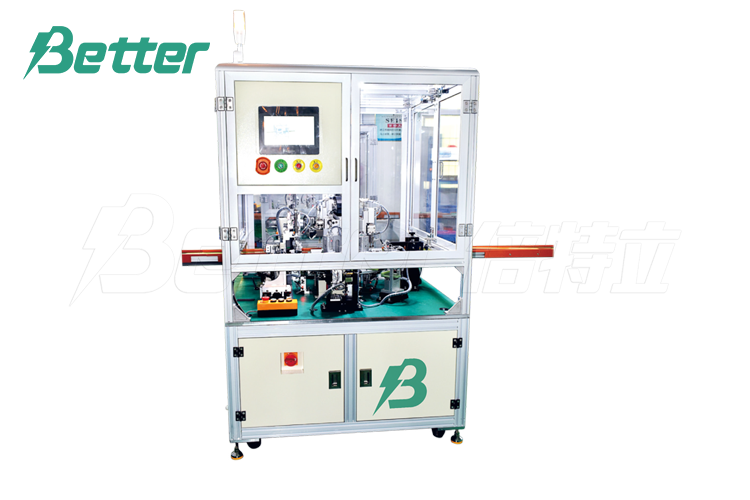
How to Choose the Right Tail Adhesive Machine for Your Production Line
2024-09-25 18:00Introduction
When selecting automated equipment, many manufacturing companies face the crucial question of how to choose a tail adhesive machine that not only boosts production efficiency but also balances cost-effectiveness. With a wide variety of equipment available on the market, finding the most suitable machine for your production line is essential. This guide provides a detailed purchasing roadmap to help companies make informed decisions.
Identify Your Production Needs: Customization is Key
Before purchasing a tail adhesive machine, companies should first identify their specific production needs. These needs encompass various factors, such as product specifications, production volume, and the manufacturing environment.
Battery Specifications and Production Process: Different tail adhesive machines cater to different battery specifications, such as limitations on length, width, and height, as well as adhesive shapes (flat, U-shaped, L-shaped). Ensure the equipment fully meets these requirements before purchasing.
Production Scale and Pace: The pace of the production line determines the required speed of the equipment. For high output needs, opt for a high-speed and efficient tail adhesive machine to avoid bottlenecks. Conversely, for smaller production volumes, a medium-speed model can help save costs.
Production Environment Constraints: Some production environments may have specific requirements for equipment footprint, operating space, and noise levels. Consider these factors when selecting equipment to ensure it fits your facility layout and production environment.

Key Technical Parameters: How to Interpret Critical Metrics
Understanding the technical parameters of a tail adhesive machine is a crucial step in the selection process. Pay particular attention to the following key metrics:
Adhesive Precision and Consistency: Precision directly affects the appearance and functionality of the product. High-precision equipment can reduce defect rates and enhance final product consistency, which is especially critical for high-end battery products.
Level of Automation and Intelligence: The degree of automation influences ease of operation and production stability. Prioritize equipment with features such as auto-calibration, vision inspection, and intelligent control, which can significantly reduce manual intervention and enhance automation levels.
Energy Consumption and Power: Equipment energy consumption affects not only operating costs but also compliance with environmental policies. Selecting equipment with low energy consumption and high efficiency supports green manufacturing trends and helps reduce electricity expenses.
Scalability and Compatibility: As your company grows, production demands may change. Tail adhesive machines with modular design and scalability can adapt to changing needs without the need for frequent replacements or upgrades.
Choosing a Reliable Supplier: It’s About Finding a Partner, Not Just a Product
The choice of supplier directly impacts product quality, service experience, and long-term benefits. When selecting a supplier, consider the following factors:
Supplier’s Industry Experience and Credentials: Suppliers with extensive industry experience and strong credentials are more likely to offer reliable equipment and robust after-sales support.
After-Sales Service and Technical Support: Equipment inevitably encounters issues during use. Opting for suppliers that offer comprehensive after-sales services can minimize downtime and repair costs. Check if the supplier provides installation, commissioning, technical training, and repair services, and assess their response speed and professionalism.
Market Reputation and Customer Feedback: Research feedback from other customers who have used the supplier’s equipment to gain a direct understanding of its performance and the quality of service. Information can be gathered from industry forums, case studies, and direct interviews.
Cost and Return on Investment: Analyze Every Expense
When choosing a tail adhesive machine, companies must consider both costs and return on investment (ROI). Equipment selection involves more than initial purchase costs; long-term operating, maintenance, and upgrade expenses should also be factored in.
Equipment Purchase Cost and Value for Money: Equipment prices can vary significantly between models and brands. Evaluate the cost-effectiveness of the equipment based on its performance, quality, and supplier services, rather than simply opting for the lowest price.
Operating and Maintenance Costs: Efficient tail adhesive machines typically have lower energy consumption and maintenance needs, directly affecting long-term usage costs. Investigate the equipment’s energy usage and routine maintenance costs during the evaluation process.
Return on Investment Period: Consider the ROI period of the equipment and assess whether its benefits can recover costs within a reasonable timeframe. Generally, a shorter ROI period indicates lower investment risk and more attractive financial returns.
Trial and Validation: Test Before You Buy to Ensure Optimal Performance
Before making a final purchase decision, companies should seek trial opportunities for the equipment. Testing the machine in an actual production environment allows for a more accurate assessment of its performance and suitability.
Equipment Trial and Practical Evaluation: Request a trial from the supplier to observe the machine’s performance in real-world operations, including stability, adhesive quality, and production efficiency.
Visit Other Users’ Production Lines: If possible, visit production lines of other companies that have already installed the equipment to observe its real-world application. This firsthand experience can help companies make more confident decisions.
Sample Testing and Quality Inspection: During the trial, produce samples and conduct thorough quality inspections to ensure the equipment meets production requirements and customer standards.
Conclusion: Choosing the Right Tail Adhesive Machine to Add Value to Your Production Line
Selecting a suitable tail adhesive machine requires companies to assess their own needs, consider equipment technical parameters, evaluate supplier service quality, and weigh long-term cost benefits. Through detailed evaluation and trial validation, companies can ensure that the chosen equipment not only meets current production requirements but also leaves room for future expansion. Ultimately, the right tail adhesive machine will become a key asset for boosting production efficiency and enhancing product quality.
